Seeing your dog have muscle spasms can be a scary experience as a pet owner, especially if you don’t know why the spasms are occurring. A dog can have muscle spasms for a number of reasons and they can often mean different things are happening within them, some more a cause for concern than others.
While often not any reason for panic, a dog having spasms is still a situation that requires veterinary attention. Taking them too lightly can lead to serious consequences for your dog, depending on the source of the underlying problem.
What Are Muscle Spasms?
Muscle spasms are localized twitches that can pop up anywhere in a dog’s body. They are the result of overexertion, neurological damage, or a physical injury. A dog that participates in strenuous physical activity, or doesn’t take in enough fluids, can have his muscle contractions interrupted, which can result in localized muscle spasms. The spasms can often be a sign of a strained muscle or some other physical damage.
The spasms are not serious themselves, but they can be painful to the dog, especially if they have been occurring over a long period of time. Muscle spasms are not life-threatening, but can be a sign of a more serious underlying condition that may require immediate medical attention. These may include a pinched nerve, slipped disc, or muscle damage.
Spasms can most often be seen as tremors beneath the skin. A trip to the veterinarian will be necessary to get a proper diagnosis on the spasms and their underlying cause.
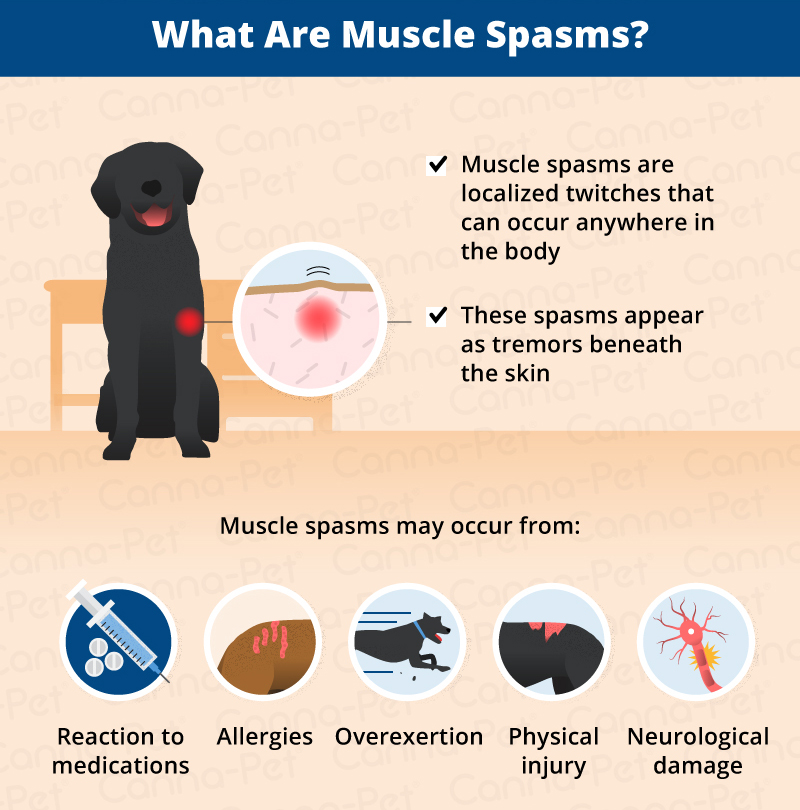
What Do Canine Muscle Spasms Look Like?
Muscle spasms in dogs are typically easy to notice and will look like twitching or tremors in a particular area of the dog’s body. They can also be detected by touch. The spasms are usually a response to some other injury or medical condition, which may cause additional symptoms to be present on top of the spasms. These can include lameness, depression, and pain.
Muscle spasms can be seen in any body part in an affected dog. The spasms may be localized or generalized, depending on their location and severity. It’s important to note that muscle spasms are different than muscle twitches or tremors.
A muscle spasm is an involuntary contraction of a muscle, while a tremor is an unintentional and uncontrollable rhythmic movement affecting a single part of the body or limb. A twitch is an uncontrolled fine movement of just a small portion of a larger muscle.
Also important to note, is that when a dog has a spasm, it can mean several different things.
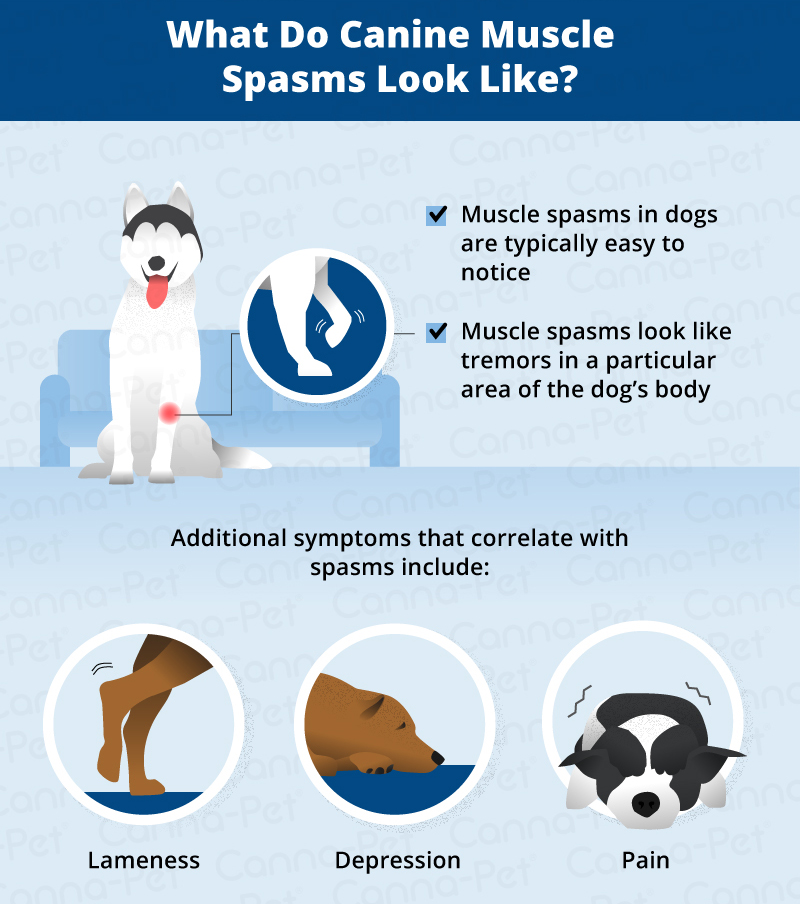
When spasms are related to seizures, there are several common symptoms that the owner can look for. Symptoms from seizures may manifest as noticeable changes in the dog’s behavior, restlessness, and some apprehension before another seizure hits. If these signs are the prelude to weirder and more extreme physical activity and body movements, as well as drooling, twitching, and even a loss of consciousness, it will become clear that these are not just muscle spasms.
The spasms also may be related to illness, reaction to some medications, or even allergies. The spasms could just be an indication of some pain in that part of the dog’s body. Most often, you will see the spasms in the dog’s hind legs or back.
Since it can be difficult to differentiate between seizures and spasms, it is best to see your veterinarian to get a proper diagnosis. You may also need to seek a specialist, such as a chiropractor or veterinary neurologist, to best determine the source of the problem and whether or not it is bone or muscle based. Finding the cause of the spasms will be vital to your dog’s health so he can receive proper treatment for whatever is causing the symptoms.
When seizures and epilepsy have been ruled out as possible causes, you can be pretty sure that the cause is some kind of pain. The pain can range from mild and temporary to life threatening. Tremors that result from seizures are distinguishable from muscle spasms because they are not localized, whereas spasms will be seen only in the affected area.
What Causes Muscle Spasms in Dogs?
Muscle spasms in dogs can be caused by a wide variety of conditions, ranging from strains and injuries to neurological disorders, allergies, dehydration or even reactions to medication.
Spasms are the result of normal muscle contraction becoming interrupted, which can also cause cramping if they go on for long enough. Cramping can be the result of nerve damage, physical injury, or pain in the dog’s back or legs.
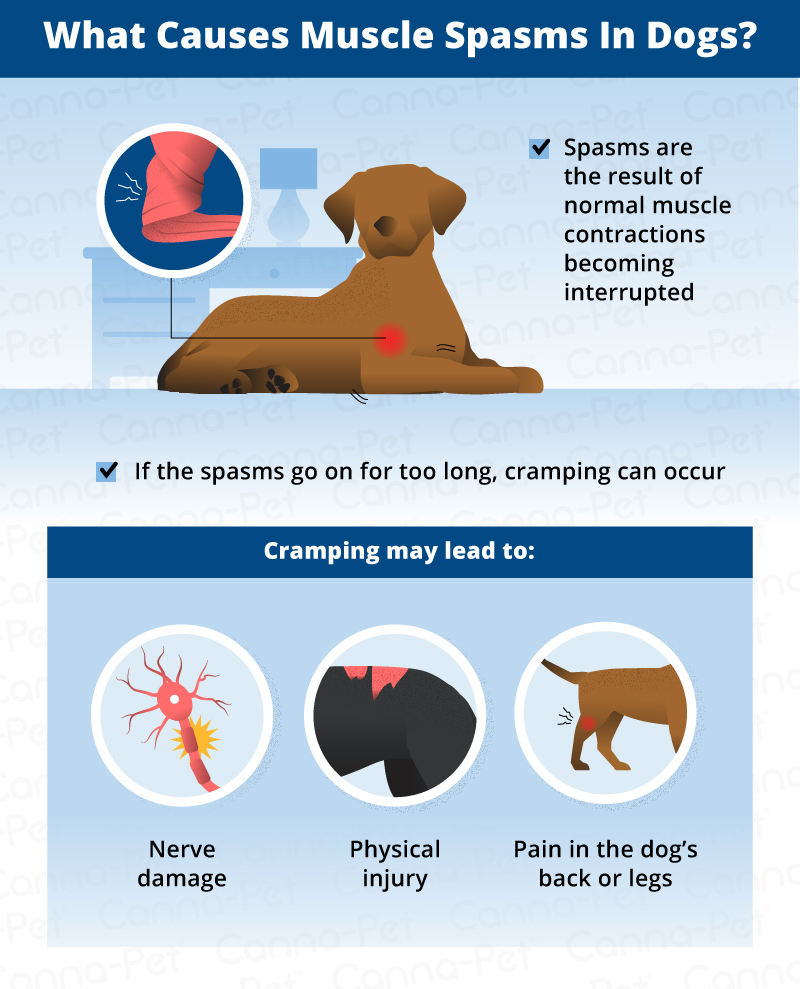
Muscle Spasms Caused by Injury
This is the most common cause of muscle spasms in dogs. When injury is the cause of spasms in a dog, the legs or back are usually the sources of the pain, but an injury anywhere in the body can cause a muscle spasm. This occurs because the muscles tense up in an effort to protect and brace the injured area or damaged joint. Dogs with unusually long backs, like Dachshunds and Basset Hounds are more prone to back spasms than other breeds.
Muscle spasms in the legs can suddenly appear in any dog of any breed. Typically, they are the result of over-activity or an abrupt movement. If the pain does not appear to be severe, you can usually let the dog walk it off, however if the spasms persist, the injury is more serious than originally thought.
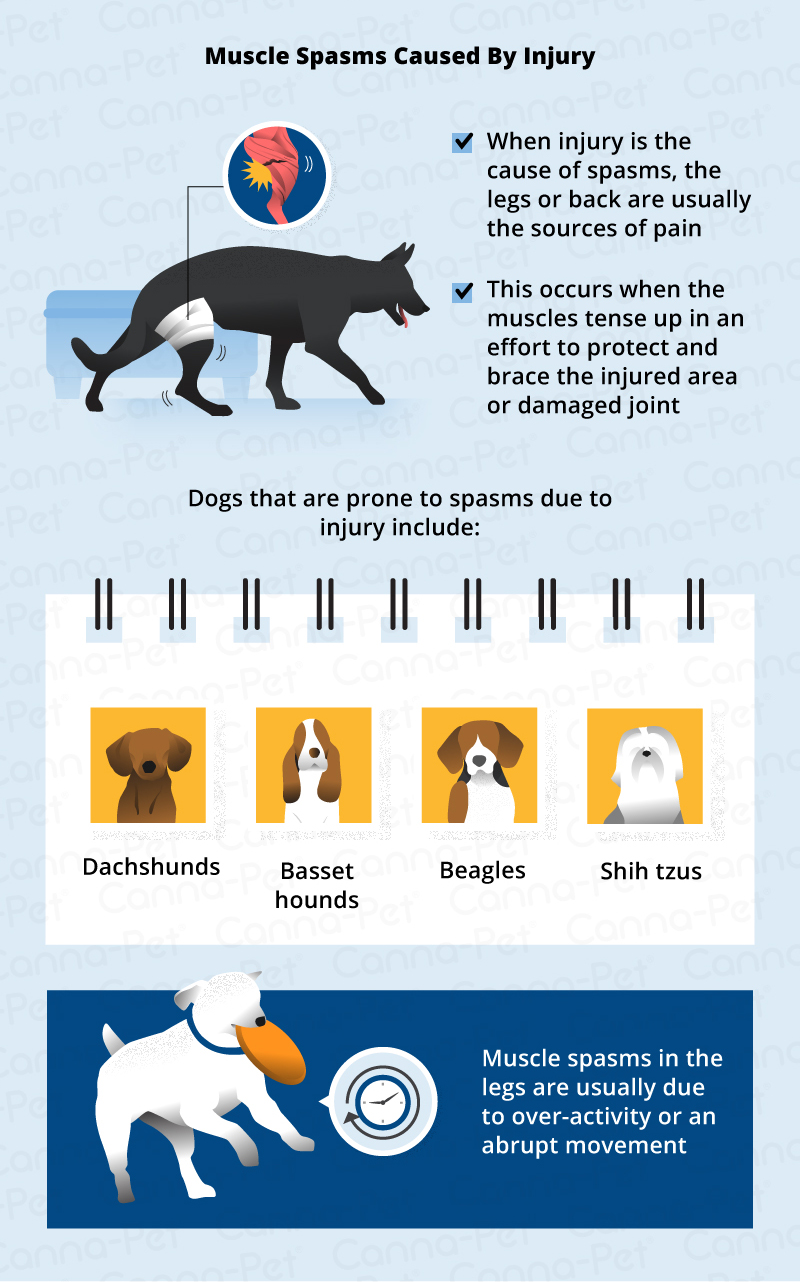
Degenerative Myelopathy
Degenerative myelopathy is caused by a loss of nerve function in the spinal cord. This is most commonly seen in German Shepherds, but can occur in other dog breeds as well. When degenerative myelopathy is the cause, the initial symptoms can include weakness in the hind legs and a loss of coordination. Unfortunately, the only current treatment options for spasms caused by degenerative myelopathy are exercise and supportive care.
Canine Stress Syndrome
One cause of muscle spasms in dogs that is often mistaken for epilepsy is Canine Stress Syndrome (CSS). This might be because CSS is a hereditary condition which can cause muscle tremors and seizures in addition to spasms.
While the condition is thought to be neurological in nature, spasms that are brought on by CSS are the result of psychological stress. This condition is most often seen in Labrador Retrievers.
Epileptic Seizures
While muscle spasms and seizures are different events, seizures can actually cause spasms to occur as well. Epilepsy will cause recurrent seizures in dogs, and there may be spasms as a result of the recurrent behavior. There are treatments available for seizures, but muscle spasms may persist, even if the dog is under medication.
Muscle Weakness Caused by Hypoglycemia
When a dog’s muscles become weakened, he will be more susceptible to spasms. Hypoglycemia is a condition in which a dog’s blood sugar drops and makes his muscles weak. This commonly affects toy breeds or puppies under three months of age. Dogs under stress may also be susceptible to hypoglycemia. Other symptoms can include lethargy and confusion.
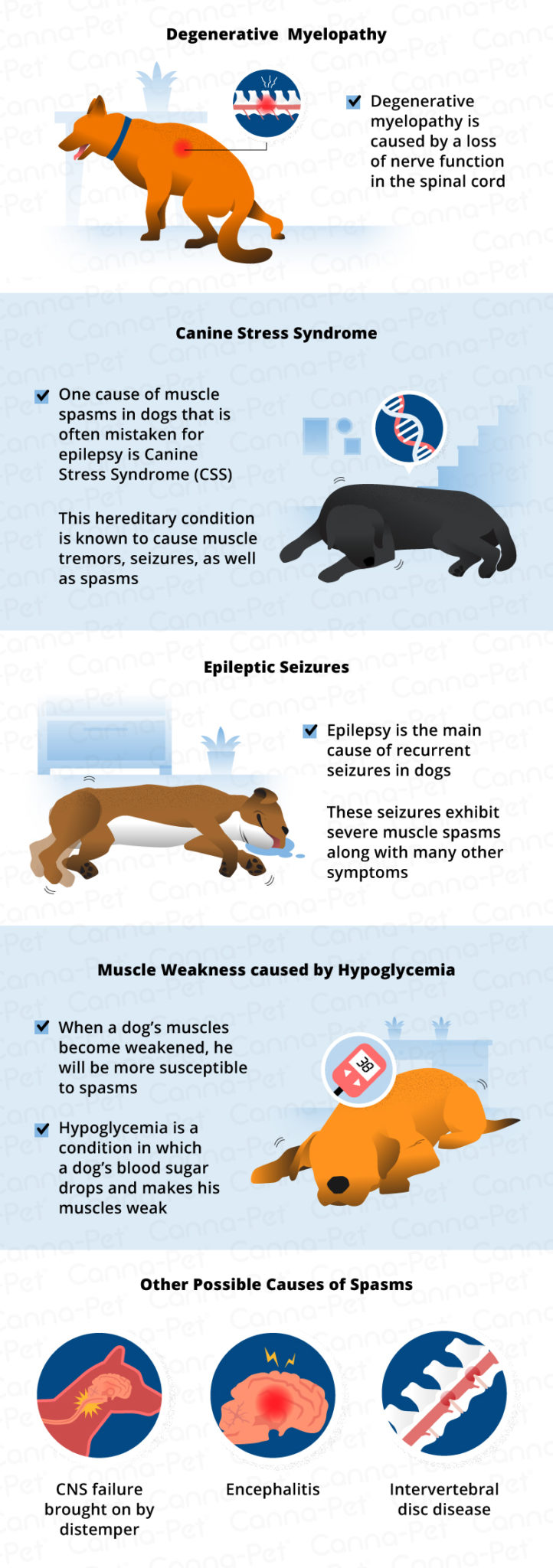
Other Possible Causes of Spasms
While the most common causes of muscle spasms in dogs are physical or neurological, viruses, toxins, and disease can also be a cause.
Encephalitis
Brain tumors and encephalitis can cause muscle spasms. Encephalitis, a swelling of the brain, is spread by mosquitoes. There is a type that is specific to the Pug, as well. Brain tumors and encephalitis require immediate veterinary treatment.
Intervertebral Disc Disease
Intervertebral Disc Disease (IVDD) is another condition specific to dogs, wherein the discs in the spinal column become herniated into the spinal cord area. IVDD can cause spasms, but in more extreme cases, can also lead to paralysis if the discs press against critical nerves in the spine too hard. If this is identified as the cause of your dog’s spasms, immediate medical surgery may be necessary to stop the problem before things get worse.
CNS Failure Brought On by Distemper
Distemper is a serious condition in dogs that can often be fatal. This contagious disease affects the central nervous system and can cause CNS failure. Dogs are typically vaccinated against distemper, but there is no cure for the disease.
While muscle spasms can occur as a result of distemper, they will be of far less concern if distemper is indeed the cause. Since distemper can be life threatening, you should contact your veterinarian immediately if you suspect it might be the cause of your dog’s spasms.
How Are Muscle Spasms in Dogs Diagnosed?
If you start to notice your dog experience localized twitches or tics beneath his skin, your dog is probably suffering from muscle spasms. Sometimes, the spasm will clear on its own simply through rest and fluids, but if the spasms persist, you will need to bring your dog into your veterinarian. This is especially true if the muscle spasm is accompanied by any other symptoms, such as lameness or pain.
Your veterinarian will perform a physical examination of your dog to locate the source of the spasms. You should always give an accurate report of your observations of the muscle spasms, including when your first noticed the spasm, what kind of activity your dog was doing prior to the first appearance, your dog’s normal fitness and activity levels, his medical history, any current medications your dog is on, any recent injuries and anything else that might be helpful.
Once your veterinarian identifies the source, further tests may be required to identify the cause of the problem. If your veterinarian is able to identify the cause, you will then put together a treatment plan for your dog, including therapy to relieve the discomfort and prevent further spasms.
How Are Muscle Spasms in Dogs Treated?
Often, for isolated incidents of muscle spasms, all it will take to relieve the symptoms is fluids and rest. Keeping your dog well hydrated and making sure you don’t overwork him are two of the easiest ways to avoid muscle spasms.
When you do notice your dog having spasms or cramping, provide him with plenty of fluids and try to gently stretch or massage the affected area. You can also try heat or cold therapy to lessen the spasms and relieve any associated pain or discomfort.
If the spasms are recurring, you should consult your veterinarian to put together a treatment plan for your dog.
Additional treatment will sometimes be required to address the root cause of your dog’s muscle spasms. These may include physical therapy, massage, or even surgery to remove the affected nerve or the source of the spasms and cramping. If your dog has chronic back spasms, they can be treated with pain medication, chiropractic surgery, or acupuncture.
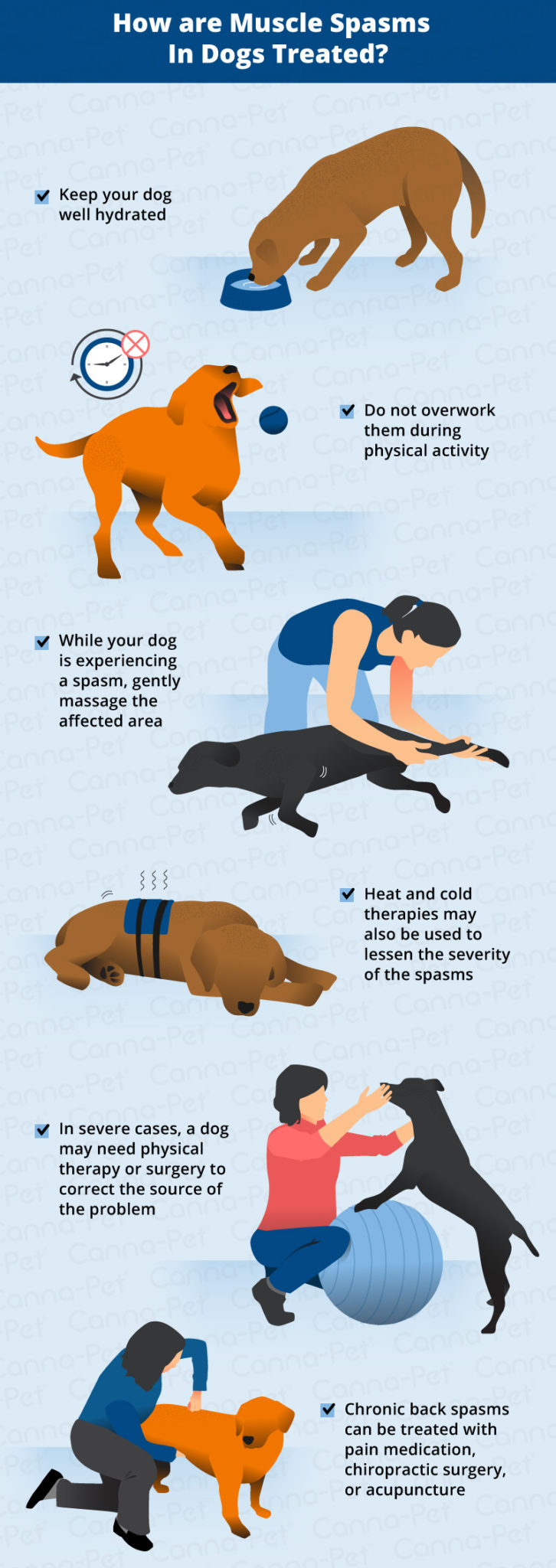
Can Muscle Spasms in Dogs Be Prevented?
It depends! But yes, often they can. Depending upon the cause, most dogs will recover from their muscle spasms without issue in a short period of time. But when it comes to spasms, the best way to ensure your dog has a full recovery is to do what you can to prevent them from happening again. And the best way to do this is through proper hydration.
When you exercise your dog or put him through your physical treatment program, make sure he has access to plenty of fluids. This is especially true on warmer days. Don’t overwork your dog or subject them to strenuous activities that may lead to a sprain or muscle injury. You can also warm them up again before any games of fetch or other intense activities. It’s also a good idea to help cool them down after activity as well.
Follow-ups to your veterinarian will be unnecessary unless your dog’s muscle spasms were the result of some other medical condition. Once the spasms have completely cleared, give your dog a more supportive diet and help strengthen his muscular system without overdoing it. Through these tactics, you can help prevent your dog from having muscle spasms again.
Sources:
- “Muscle Spasms in Dogs – Symptoms, Causes, Diagnosis, Treatment, Recovery, Management, Cost.” Wag!, 30 Sept. 2015 Accessed 4 May 2017. www.wagwalking.com/condition/muscle-spasms.
- “What Causes Muscle Spasms In Dogs?” IHeartDogs.com, 28 Nov. 2017, Accessed 4 May 2017. www.iheartdogs.com/what-causes-muscle-spasms-in-dogs/.
- “Involuntary Muscle Trembling in Dogs.” PetMD, Accessed 4 May 2017. www.petmd.com/dog/conditions/neurological/c_dg_tremors.
- “Possible Causes of Dog Muscle Spasms.” VetInfo, Accessed 4 May 2017. www.vetinfo.com/dog-muscle-spasms.html.
- “Reasons Why a Dog Would Twitch | Cuteness.”, Cuteness, 9 Feb. 2017, Accessed 4 May 2017. www.cuteness.com/blog/content/reasons-why-a-dog-would-twitch.




